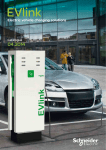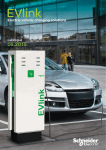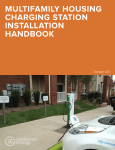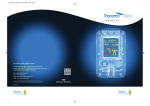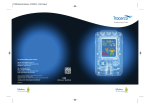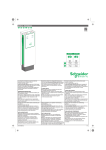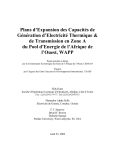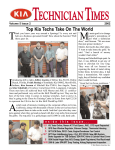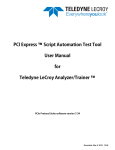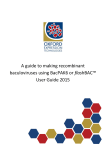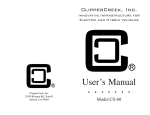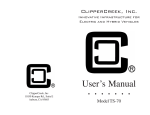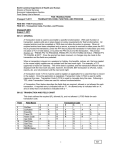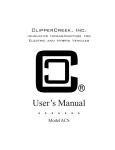Download IN-Charge at Home Program FAQs
Transcript
NIPSCO IN-Charge Electric Vehicle Program – At Home Frequently Asked Questions On February 1, 2012 the Indiana Utility Regulatory Commission (IURC) approved NIPSCO’s request to make a $1 million investment across northern Indiana in a new program to spur economic development and the adoption of plug-in electric vehicles (PEVs). GENERAL PROGRAM INFORMATION 1. What is NIPSCO’s IN-Charge Electric Vehicle Program – At Home? The program is a 3-year pilot program to promote the purchase of electric vehicles by residential customers that will be in effect through January 31, 2015. Two key features of the pilot program are: a. A financial incentive up to $1,650 per residential customer toward the purchase and installation of a Level 2 (240 volt) electric charging station, which also includes any required electric upgrades within a customer’s home, and b. Free charging during the night-time hours of 10 PM through 6 AM 2. Is charging my EV during off-peak hours actually free? Yes, charging is free between the hours of 10:00 PM to 6:00 AM 3. What will the rate to charge my vehicle be after the pilot program? At the conclusion of the pilot program period, usage will be charged according a residential customer’s applicable electric service tariff. NIPSCO may use the information gained during the pilot program to develop a Time of Use (TOU) rate for electric vehicles. 4. Since when has the program been available? NIPSCO received approval from the Indiana Utility Regulatory Commission (IURC) to offer the Program on Feb. 1, 2012. NIPSCO has been taking applications to enroll in the Program since Monday, April 2nd, 2012. 5. Where can I get further information about the program? If you would like further information about the program, you can either: a. Go to the following link : http://www.nipsco.com/en/INCharge, or b. Call our toll free number (1-855-500-6477) during the hours of 9 AM to 6 PM M-F and 9 AM to 3 PM Saturday Central timezone or 10 AM to 7 PM M-F and 10 AM to 4 PM Saturday Eastern timezone to speak to a representative. 6. How many customers can participate in the program? The program is limited to the first 250 customers, or until funding is exhausted (approximately $413,000). 7. How does the program work? Residential customers who either own, lease, or are seriously considering owning or leasing an electric vehicle can enroll for NIPSCO’s IN-Charge Electric Vehicle Program - At Home. Once you purchase or lease an electric vehicle and provide proof of ownership, you will be eligible to receive: a. A financial incentive up to $1,650 per household to be used toward the purchase and installation of a residential 240-volt charging station along with any required electric upgrades, b. A free second meter, specifically dedicated to your electric charging station, and c. Free overnight charging for your electric vehicle from 10 PM to 6 AM (local time). This service is provided under NIPSCO’s Plug-in Electric Vehicle Off-Peak Charging Rider (685) 8. What if I am currently on NIPSCO’s Budget Plan? Will enrolling in the program affect my bill? Due to the technical complexity of this program, your account may be temporarily affected if you are currently on the Budget Plan. There is a possibility that your next billing statement may show you have been removed from the Budget Plan; however, this is only temporary, until the additional meter is installed at your home. You should continue to pay your regular monthly budget amount. Once the additional electric meter is installed, your account will be placed back on the original budget amount. 9. What are electric vehicles and which ones are eligible for the Program? There are basically three types of electric vehicles; all are eligible for our program with the exception of Hybrid electric vehicles (HEVs). The types of EVs are: a. Hybrid electric vehicles (HEVs) which use a mix of combustion and electric propulsion with no recharging capabilities (no “plug in”). These are the predominant EVs on the road today. The standard non plug-in Toyota Prius is a well-known example of this type of EV. These types of vehicles are not eligible for our program. b. Plug-in electric hybrid electric vehicles (PHEVs) which are hybrid vehicles with the ability to recharge batteries directly by plugging into a charging station. These EVs began hitting the US market in volume in late 2010/early 2011. Ford, GM, Honda, Toyota and others have begun to offer these vehicles for sale. c. Battery electric vehicles (BEVs) which run solely off of a rechargeable battery pack. The Nissan Leaf, Ford Focus Electric and Tesla Roadster are well-known examples of this EV. 10. Why is NIPSCO offering this program? By encouraging consumers to purchase plug-in electric vehicles, we hope to promote early adoption and improve charging infrastructure in northern Indiana, improve local air quality, decrease the cost of operating and maintaining a transportation vehicle and help reduce reliance on foreign oil. In addition, by offering an incentive for customers to charge their electric vehicles during the off-peak, night-time hours, we delay the need to build costly generation facilities in the future. This deferral helps keep your electric costs affordable. This program is also being offered as part of a Supplemental Environmental Project under the NIPSCO New Source Review NOV settlement. 11. What do you mean by “This program is also being offered as part of a Supplemental Environmental Project under the NIPSCO New Source Review NOV settlement”? On July 22, 2011, the United States District Court for the Northern District of Indiana entered a Consent Decree between NIPSCO and the EPA resolving allegations that NIPSCO violated the Clean Air Act. As a part of the Consent Decree, NIPSCO agreed to offer several programs which reduce air emissions or preserve lands potentially impacted by air emissions. The NIPSCO IN-Charge Electric Vehicle Program is being offered as one of these programs. For more information regarding the Consent Decree, you can go to: http://www.epa.gov/compliance/resources/decrees/civil/caa/nipsco-cd.pdf 12. What is the climate impact of the electricity that will power the electric automobiles? Both all-electric vehicles and plug-in hybrids have the ability to reduce greenhouse gas emissions. One of the major greenhouse gases is carbon dioxide (CO2). When emissions from electric power generation are considered, an all-electric vehicle reduces CO2 by over 30% compared to a conventional gasoline vehicle. See the Department of Energy Website for further information and for comparisons in your area. 13. Does the energy supplied by NIPSCO to charge the vehicles come from green sources? Yes, the IN-Charge Program uses green power via Renewable Energy Credits (RECs) to supply charging to electric cars. For more info on RECs, visit: http://www.epa.gov/greenpower/gpmarket/rec.htm 14. What other kinds of charging options are there, besides home charging? Besides home charging, there are various types of public and semi-public charging stations that have been installed in and around northern Indiana. They are typically installed at workplaces, shopping malls, retail stores, and other places where drivers have planned stops for a few hours and can charge while taking care of other business. 15. How will I be able to find public charging stations? The DOE’s Alternative Fuels and Advanced Vehicle Data Center has a very good website that can help you locate charging stations anywhere in the US and located at the following link: http://www.afdc.energy.gov/afdc/locator/stations/ In addition, smart phone applications are available to identify fast charging stations for public use. Smart vehicles currently in development may also proactively suggest when you might want to stop for a fast charge, if you are running low and/or are near a public charging station. 16. Will NIPSCO offer any publicly-available charging stations? Yes, NIPSCO will install and make available up to 10 publicly-available charging stations at NIPSCO’s facilities. Currently NIPSCO has two Level 2 charging stations (each with 2 ports) and two Level 1 charging stations at its Merrillville location. NIPSCO is considering additional stations at its other facilities. Stay tuned to NIPSCO.com for updates. 17. Will NIPSCO eventually expand this program? A second phase of the pilot program is currently under development. Stay tuned to NIPSCO.com for updates. ELIGIBILITY 18. Who is eligible to enroll in the program? In order to be eligible to enroll in the Program, the applicant must meet the following criteria: a. You must be a NIPSCO residential “electric” Customer (on Rate 611 or 612) with an active account in your name, b. You must certify that the electric vehicle is either owned by you or another resident living at your home is SAEJ-1772 compliant, c. You must be able to show proof of ownership or delivery of the Electric Vehicle (in order to receive the financial incentive), and d. You must either have - or intend to install- a hardwired Level 2 (240 volt) residential charger with a dedicated circuit. 19. Can I apply for the program even if I don’t own an EV but am thinking of purchasing or leasing one? Yes. Residential customers who are in the process of purchasing or leasing an electric vehicle can apply to be enrolled in the program but will be charged $99 for the in-home estimate. If you proceed with the purchase or lease of an electric vehicle and enroll in the program within 60 days following your in-home estimate, the $99 will be refunded back to you at the time of installation. If you decide not to purchase or lease an electric vehicle, the $99 is not refundable. 20. Does it matter if I have a plug-in hybrid or a battery-electric car? No. The program is available to NIPSCO customers who purchased a new EV with a factory installed SAE J1772 connector and who install a Level 2 (240-volt) home charger served by a separately-metered dedicated electrical circuit, no matter the make or model of the electric vehicle, provided it is new and has a factory installed SAE J1772 charging plug. 21. What if I already own/purchased an in-home charging station? Customers who already own a Level 2 (240-volt) charging station can use program funds to pay for any and all electrical work that is required to have the charging station “hardwired” (if it’s not already) and assure that it’s served by a separately-metered dedicated circuit. 22. What if I am a NIPSCO residential electric customer, but don’t own my home? If you have an active NIPSCO electric account, but don’t own the residence where the service is being provided, you must provide written approval from the property owner to install the charger, and the property owner must also sign and agree to the terms and conditions of the Program. You also need to have a dedicated parking spot. 23. What if I have NIPSCO gas service or am served by a municipality or rural electric cooperative that purchases its electric power supply from NIPSCO? Only current NIPSCO residential electric customers are eligible. PROGRAM ENROLLMENT 24. How do I enroll in NIPSCO’s IN-Charge Electric Vehicle Program – At Home and get my charger installed? NIPSCO is working with South Shore Clean Cities (SSCC) to administer the program and with PH Current Electric to provide cost estimates and home charging station installations. To enroll in the program, all you need to do is follow these simple steps: Step 1 Complete the Pre-installation Survey o The pre-installation survey helps us understand where you plan to park the vehicle and install the charger as well as your current electric service in your home housing with electrical services situation and vehicle parking plan. Step 2 Agree to the Terms & Conditions of NIPSCO’s Residential IN-Charge At Home Program o Within two working days following the receipt of your Pre-installation Survey, a representative from SSCC will review your application, verify your eligibility, and contact you to inform you of your eligibility. If you are eligible, our certified electric contractor (PH Current Electric) will call you in order to schedule an in-home assessment to review installation requirements and required electric upgrades. Step 3 Work with PH Current to schedule your home assessment within the next two weeks. Step 4 Meet with one of PH Current’s certified electric sub-contractors to review your choice of charging station options and receive your home assessment which will provide you with the total cost of your installation (which includes the cost of the charger and any associated permit fees). Step 5 Schedule the installation of your home charging station with PH Current Electric. Our certified electric contractor will apply for all required permits, complete your installation, and request an inspection so that NIPSCO can make arrangements with you to install your additional sub-meter. The electric subcontractor will also show you how to use your charging station. o Note: If the installation is not scheduled within 60 days of your in-home assessment, you will lose your place for the amount of the financial incentive being held for you and may need to reapply. Any amount over the $1,650 financial incentive will need to be collected by PH Current Electric prior to work being initiated along with receiving actual signatures to the Terms and Conditions of the program. Step 6 Once your charging station is installed and NIPSCO receives notification from your local Inspector that your home charging installation has been approved, NIPSCO will contact you to schedule your 2nd meter installation so you can begin to get free power for your home charger from 10 PM to 6 AM. o Note: Since the circuit breaker is closed for safety reasons, after the meter is installed you will need to be home to turn on the circuit breaker so NIPSCO can assure that your meter is working properly. 25. What do you do with my information? What are you going to do with my VIN number? The information is stored in a secure database and will be used to verify your eligibility for the IN-Charge Program. 26. Once the available amounts of financial incentives are gone, can I still apply for free overnight charging? Yes. NIPSCO will continue to offer free overnight charging after the full amount of financial incentives are gone. However; you will need to have a hardwired Level 2 charging station installed to a dedicated circuit. Additional costs will apply for the installation of the separate meter to measure the usage of the charging station. As part of the pilot program’s approval by the Commission, there is a $250,000 cap on the total amount of fuel cost associated with free EV charging, so NIPSCO will monitor this level before taking any applications after the amount of available financial incentives have been depleted. CHARGING STATIONS 27. Why do I need a Level 2 charging station for my electric car? Plug-in Electric Vehicles (PEVs) feature rechargeable batteries that supply energy to propel the vehicle. When you drive, the car consumes the battery’s stored electricity. The Level 2 charging station helps to refill your battery with electricity in about half the time it would take if you just plugged your vehicle into a standard 110-volt outlet. 28. What is the voltage requirement to run the home charging station? The charging station requires a 240VAC individual circuit. 29. Does the power have to be shut off during the installation? Possibly; the electrician performing the on-site inspection will inform you of installation procedures. 30. How much will my home charging station cost? The actual cost will vary according to the site conditions for installation and local requirements. 31. Can I take a Federal tax credit for installing a home electric vehicle charger? If so, how much of a credit is it? A portion of The American Taxpayer Relief Act, signed by President Obama on January 2, 2013 retroactively extended several tax credits that had previously expired on December 31, 2011. One of these tax credits is the Alternative Fuel Vehicle Refueling Property Credit (IRS Form 8911) which provides for a 30% tax credit, up to $1,000 for the personal use of residential home charging stations installed between January 1, 2006, and December 31, 2013. The amount of Federal income tax credit for which you may qualify can vary depending on your particular Federal income tax circumstances. Please contact your personal tax advisor to determine the appropriate credit amount. More information about Form 8911 and its instructions can be found at: www.irs.gov/form8911 32. What types of charging stations are being offered? NIPSCO is currently offering the following four options: Home Charger Avg. Retail Cost Supplier Amperage Max kW Voltage Service panel breaker Indoor/Outdoor Residential Home EV Charging Stations Evr-Green LCS - 25 Watt Station (EVB22-3PM) $769 $999 $999 ClipperCreek General Electric Leviton 25A 30A 16A 4.8 kW 7.2 kW 3.8 kW 240 208-240 240 25A w/ 2 pole 40A w/ 20A single phase, 2-wire dedicated circuit Both Both Both EVlink 30A $799 Schneider 30A 7.2 kW 240 2 pole 40A w/ dedicated circuit Indoor Only Image 33. How do I know what charging option is best for me? In determining your charging needs, consider your driving habits, the type of car you would like to buy, and the amount of time you will typically have to charge your car. Level 1 charging (120-volt) takes longer than Level 2 (240-volt), but it does not require the installation of a special charging unit if your garage or parking area is equipped with the appropriate outlet. The rebate does not apply to Level 1 charging. 34. How will my home charging station work? Your home charging station will typically be mounted on your garage wall and be hardwired to a dedicated circuit in your home’s electrical system. You’ll connect the station to your PEV when you park it, and disconnect it when you’re ready to drive. 35. What happens if the charging station gets wet? Most home charging stations are rated for both indoor and outdoor use. A NEMA 4 enclosure protects the equipment from dirt, dust, and water or ice damage. The only charging station we offer that cannot be installed outdoors is the Schneider EVLink. 36. What are my future maintenance needs for my charging station? For post-installation maintenance needs, the manufacturer’s warranty applies. Contact the manufacturer directly for clarifications. INSTALLATION 37. What are the home technical specifications needed if I want home charging? The technical specifications for home charging installation will vary for each individual customer based on their desired home charging location and home information (i.e. year home was built, attached or detached garage, existing 240-volt line, etc.). 38. Why would I need to upgrade my electric service to use a Level 2 charger? The U.S. National Electrical Code (NEC) requires that a 240V charger have its own dedicated outlet, which will typically require an electrical upgrade performed by a licensed electrician. 39. Who will install my EV charger? We have contracted with specific electrical contractors that are trained and qualified to install each of the charging stations that are available to you through this program. The contractors are experienced in working with each of the charging station options and the various steps throughout the installation process. 40. How do I know if my electrical panel at home has a 40amp spare? If not, what do I do? How will I know if the electrical panel of my residence needs an upgrade? The electrician performing your assessment will provide an estimate for the upgrade and explain the upgrade process. 41. Can I install the charger in my driveway? You can install the charger in your driveway, but it must be rated for outdoor use and be mounted onto a wall (typically a side of the house). 42. I want my charger to be installed outside of my garage, is it weather-proof? You will need to refer to the specification table of the charging station you chose. 43. I already have a charging station installed in my home, but it is not one of the brands you are offering; can I still qualify for the NIPSCO Residential IN-Charge Program? As long as you are a NIPSCO-electric customer, you are still able to apply for eligibility for this program with your previously purchased home charging station, but it must be hardwired. We will also need to know the technical details – type of charging station, brand, hard-wiring, type of connector, etc. Once you qualify and have the additional meter installed, you can begin to receive electric service for your charging station under NIPSCO’s Plug-In Electric Vehicle Off-Peak Charging Rider which provides free charging during 10 PM through 6 AM. 44. How long will the entire installation process take? Once you’ve decided to continue to enroll in the program, the entire process should take approximately two to three weeks. The actual amount of time will depend on local permitting agency requirements, your scheduling availability, and how soon the local inspection agency can fax your installation approval into our district office. Due to current regulations, NIPSCO cannot install the 2nd meter until we receive this fax from the inspector. 45. How long will it take to get a permit for charger installation and how long will it take the inspector to fax in my installation approval? This depends on the permitting process and inspectors of the municipality you live in. We are working with the various communities in NIPSCO’s electric service territory to expedite both of these processes. 46. What is the electrical panel upgrade process? How long will it take? Anywhere from one to four days, depending on what needs to be done. 47. Once my charging station is installed and inspected, how long will it take to get the 2nd meter installed so I can begin receiving free night-time charging? Once NIPSCO receives notification (via fax) from the inspector that your installation is approved, a representative from NIPSCO will contact you to confirm a date with NIPSCO to install your second meter. Typically, this takes approximately 3-5 business days, depending on your scheduling availability. 48. Why does NIPSCO have to put in a separate meter, and what kind of meter is it? In order for NIPSCO to offer the free night-time charging, the usage of your charger must be separately metered. In addition, since free charging is only during the hours of 10 PM through 6 AM, the separate meter will record the hourly usage of your charger, so you are billed appropriately. 49. Will the separate meter need a separate panel to be installed? The electrician who will perform the on-site assessment will determine if a separate panel is needed for your home. EV CHARGING USAGE AND COST 50. How much will it cost me to charge my car at home? If you charge your vehicle during the hours of 10 PM to 6 AM, there is no cost to charge your vehicle. If you charge your vehicle other than these hours NIPSCO will charge your usage at your normal residential rate. 51. How much electricity is required to charge my EV? The amount of electricity drawn by your EV will vary depending on the battery size of your vehicle, your driving and charging habits. If you drive only a short distance each day or if you charge at locations other than your home charging station, you will need less energy to recharge your EV and thus will use less electricity when you charge at home. Electric vehicles get anywhere from 3 to 6 miles per kWh depending on the vehicle and how you drive. If you assume an average of 4.5 kWh per mile, if you drive 40 miles per day you will use about 8.9 kWh (40 miles/4.5 miles per kWh = 8.9 kWh). 52. What is the cost per mile of an electric vehicle compared to a vehicle that only uses gasoline? With NIPSCO’s IN-Charge At Home Program the cost per mile of an electric vehicle is 0 cents/mile if you charge during night hours and approximately 2 cents/mile if you charge during on-peak hours. Compared to gasoline, if you assume gasoline costs $3.65 per gallon and your car gets about 30 MPG, it will cost you 12 cents/mile using gasoline (12 times higher than the PEV off-peak rate and 6 times higher than our PEV on-peak rate). 53. How will I know if my EV is fully charged? Your EV will indicate a fully charged battery. You can also program your EV manufacturer’s phone app to send you a text message when the car is fully charged or a charge suddenly stopped. Some home charging stations also allow you to set up notifications; however each device is different, so you will need to refer to the user manual for your device for specific indications. The on board vehicle diagnostics of your EV will also provide this information. 54. Can I program my car or charging station to charge only during NIPSCO’s night time hours? Any electric vehicle with a telematics system (such as the Nissan Leaf) can be programmed to start and stop charging at a specified time. You should refer to your electric vehicle’s manual and your charger specifications for more details on the availability of programming options for your vehicle. 55. How long will it take to charge my EV? You will need to refer to your vehicle’s manual. 56. How fast can EVs charge with a Level 2 station? This depends on the model of your charging station and the type of electric vehicle you are recharging. The time required to fully recharge EVs ranges from 3 to 10 hours. The charge time can also be much less, depending on the amount of charge remaining in the battery when you begin the charging process, the size and chemistry of the battery, and other conditions. For example, the Chevy Volt’s 16 kWh (10.4 kWh usable) lithium-ion battery pack can be fully charged by plugging the car into a standard U.S. 120V residential electrical outlet in approximately 10 hours for a full charge. Using the Level 2 home charger (for example, the Voltec™ 240V), the Volt’s battery can be recharged in about 4 hours. 57. How do I know if the EV is charging? All home charging stations have easy to read indicator lights to provide charging and system status. These indicators may be either on the body of the charging station or on the plug-in cable itself. The indicator light definitions are usually provided in the user manual for the charging station. 58. Will the charging station stop automatically when the battery is fully charged? Yes, all home charging stations will automatically stop drawing and transmitting electricity when the EV is fully charged. 59. Can I stop charging the EV before it is 100% charged? Yes, you may stop charging your EV at any time. Refer to the user manual for your charging station for any special procedures. 60. When the EV is fully charged, does the charging station continue to draw electricity? Home charging stations are designed to be energy efficient, but when charging is complete they will continue to draw an extremely low amount of standby power – only enough to power the LED lights and other internal monitoring systems of the charging station itself. 61. How far will a full charge get me? Driving distance depends on the vehicle’s range. If a vehicle’s battery has a stated 100 mile range, a full charge is expected to deliver 100 miles, depending on many conditions. Actual range will vary depending upon driving/charging habits, speed, conditions, weather, temperature, and battery age. 62. What happens if my car is not charging? There can be several reasons why your car is not charging, please contact SSCC to go over the general diagnostic steps with you (855) 500–6477.












